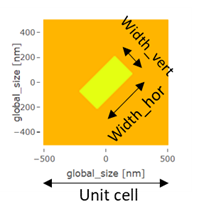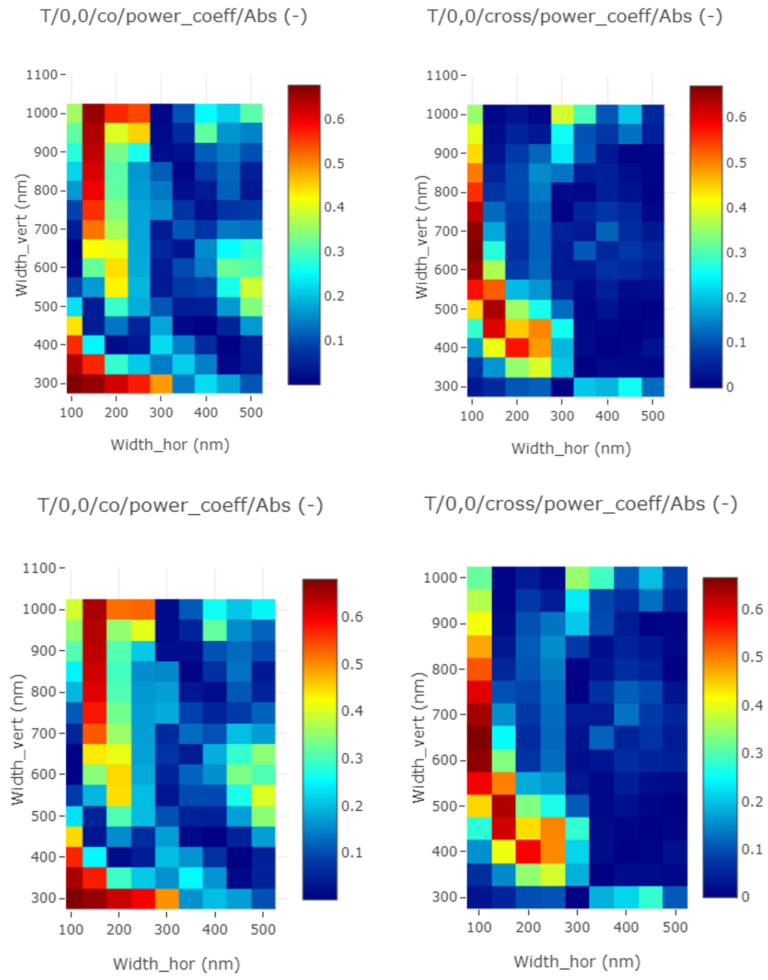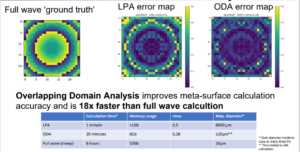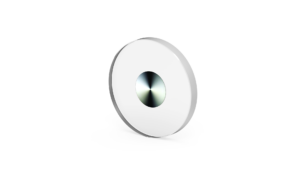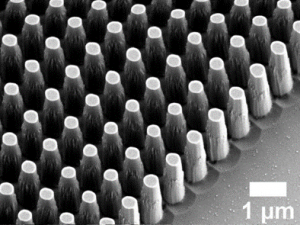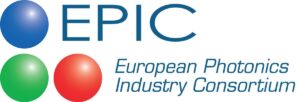Reading time: 8 minutes
Written for: optical engineers, photonics engineers, researchers, technology scouts
Extra-relevant if you are interested in: meta-surfaces , HWP, birefringent meta material
Versatile design of half wave plates (HWP) based on metamaterials
Half-wave plates are one of the standard components one can find in any optical lab next to lenses and neutral density filters. The direct use of a meta-surface half wave plate (HWP) might sound overkill since a planar thin HWP can be made with birefringent materials quite easily. Though, imagine a lens with spatially multiplexed features, a specific broadband or multi wavelength design,… In those cases this meta-lens based HWP is a versatile structure since it can be tailored and as such the ideal starting point for more complex designs [1] [2] [3] [4]. Here we will discuss how to create one with the PlanOpSim MetaCell module guided by a literature example [1]. As for any meta-component design, first a meta-cell library has to be created, and afterwards the meta component is built from this meta-cell set.
Physical background
A HWP retardates one orthogonal polarisation compared to the other with a phase shift. These polarisations are the ordinary and extraordinary polarisation of the HWP. To transform horizontal incident polarisation (TE) into vertical output polarisation (TM) one places this HWP with the ordinary polarisation under an angle of 90° compared to the incident horizontal polarisation. As such, at each location of the meta-lens we need the same 180° phase delay for ordinary compared to extraordinary polarisation. This means that we only have to find a single meta-atom with this delay and reuse it in each location in the meta-surface.
First of all, creation of a birefringent meta-material in the wavelength range around 1700 nm is done with silicon, a material with no birefringence material. The birefringent properties result from the rotational asymmetry over 180° resulting in differences in the ordinary and extraordinary directions. With this rotational asymmetric requirement in mind, any design with this rotation limitation might, with the right size and height, result in a candidate meta-cell for a half wave plate. In combination with the fact that the ordinary axes and extraordinary axes should have a large difference in refractive index to create a thin meta-lens, a rectangle turned over 180°![]() is selected as visualised in Figure 1.
is selected as visualised in Figure 1.
Meta-cell: Coarse search
Simulation of meta cells with multiple degrees of freedom requires quite some computing power. To reduce this, first of all the meta cell size is fixed initially to 1000nm, chosen as such to be able to compare results with [1]. Secondly, the accuracy is appropriately chosen.
The PlanOpSim simulation tool uses a rigorous coupled-wave analysis (RCWA) which is based on a fourier decomposition in the normal plane. The amount of fourier components taken in the solution can be set fairly low during the coarse search of a meta-cell. To find the appropriate accuracy levels, a quick simulation is done with a selected meta-cell configuration and different accuracies as visualised in Figure 1. The simulated transmission of this rectangle starts converging around an accuracy of 4 and is well converged for an accuracy of 8. In this study the former will be used, the latter might be useful for a final analysis.
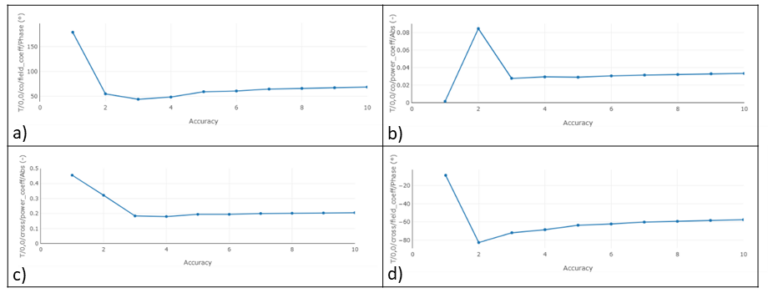
A coarse sweep of the ordinary and extraordinary sizes of the rectangle is given in Figure 2. Despite the small differences between low and high accuracy (top and bottom row) it is clear that the higher accuracy in the coarse search has no influence on the choice of the most suitable structure.
Meta-cell: Fine search
Based on the coarse search (Figure 3) an optimal region can be determined. The theoretical best solution from the coarse search when looking at a height of 1700nm (selected here to compare to (1)) would be 100 nm by 650 nm. This would require a high aspect ratio (about 17) and might be hard to fabricate. The best option with aspect ratio <10 is found around 200 nm by 400 nm, which is as well the chosen configuration of [1]. Looking at different heights in the coarse search, the 200 nm by 400 nm size seems a good spot for all heights with the most promising heights being 1300 nm and 1600 nm. A fine search is done around both optimal points with steps of 10 nm (accuracy kept at the lower value of 4) as visualised for the optimal point around the 1300 nm in Figure 4 and Figure 5.
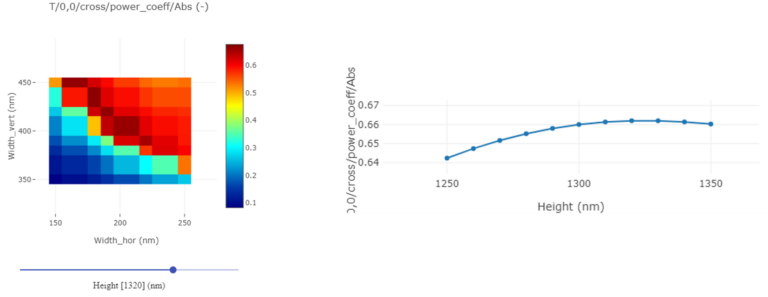
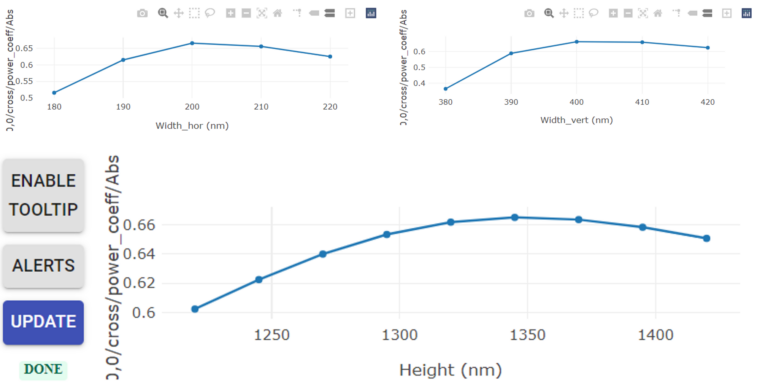
With this procedure, for both height range an optimal meta-cell is selected (depending on the transmission efficiency or conversion efficiency (Tcross/Ttotal) one will select a slightly different structure or add them all to the meta-cell group and let the program select the optimal combination for the defined target):
Meta component design
Since a HWP designed for a single wavelength has a uniform nearfield phase and amplitude content, the meta-cell library only consists of a single meta-cell reused at each location (visualised in Figure 6). Since this is a trivial configuration resulting in quasi-identical output features as the related simulated meta cell, this part is left out of this discussion.
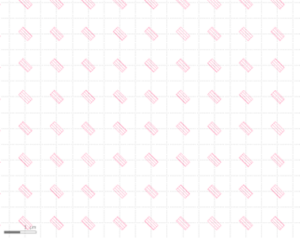
Conclusion
A metalens based half wave plate is created for 1700nm with the PlanOpSim software. A rectangular meta-atom rotated over 45 degrees is used to create the appropriate phase shift and the optimal shape is selected. The GDS-file for this metalens can be created from within the PlanOpSim software.
References
|
[1] |
Y. Dong, Z. Xu, N. Li, J. Tong, Y. H. Fu, Y. Zhou, T. Hu, Q. Zhong, V. Bliznetsov, S. Zhu, Q. Lin, D. H. Zhang, Y. Gu and N. Singh, “Si metasurface half-wave plates demonstrated on a 12-inch CMOS platform,” Nanophotonics, vol. 9, no. 1, pp. 149-157, 2019. |
|
[2] |
S. Du, Z. Liu, C. Sun, W. Zhu, G. Geng, H. Ye, J. Li and C. Gu, “Cross-nanofin-based waveplate pixels for broadband hybrid polarization coding in near-field,” Nanophotonics, vol. 10, no. 5, pp. 1505-1515, 2020. |
|
[3] |
T. Zeghdoudi, Z. Kebci, A. Mezeghrane, A. Belkhir and F. I. Baida, “Half-wave plate based on a birefringent metamaterial in the visible range,” Optics Communications, vol. 487, 2021. |
|
[4] |
Q. Zhang, M. Li, T. Liao and X. Cui, “Design of beam deflector, splitters, wave plates and metalens using photonic elements with dielectric metasurface,” Optics Communications, vol. 411, pp. 93-100, 2018. |

